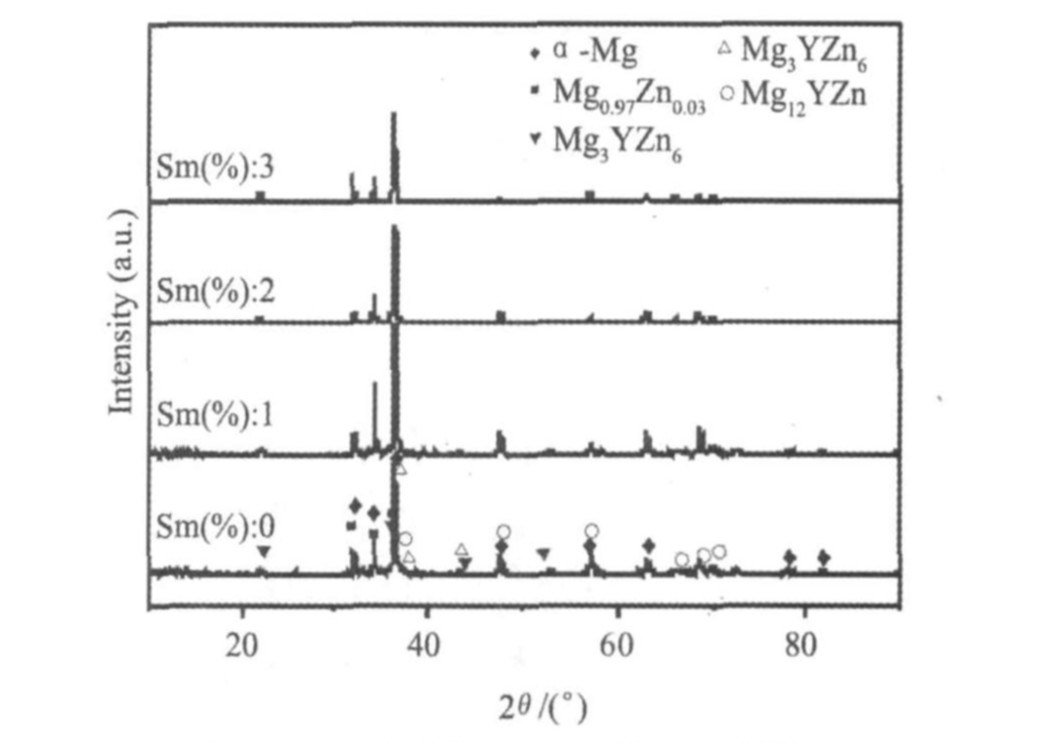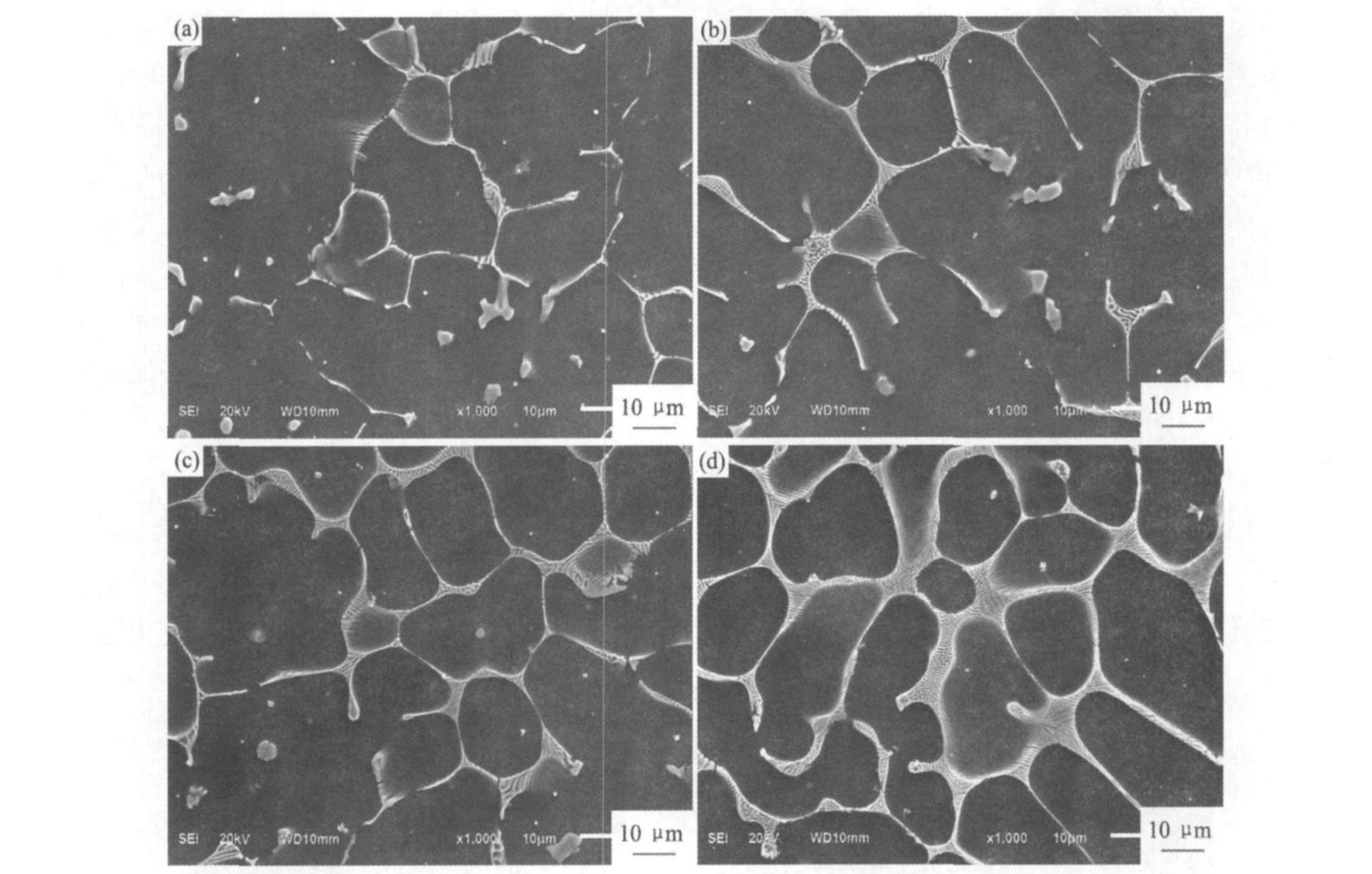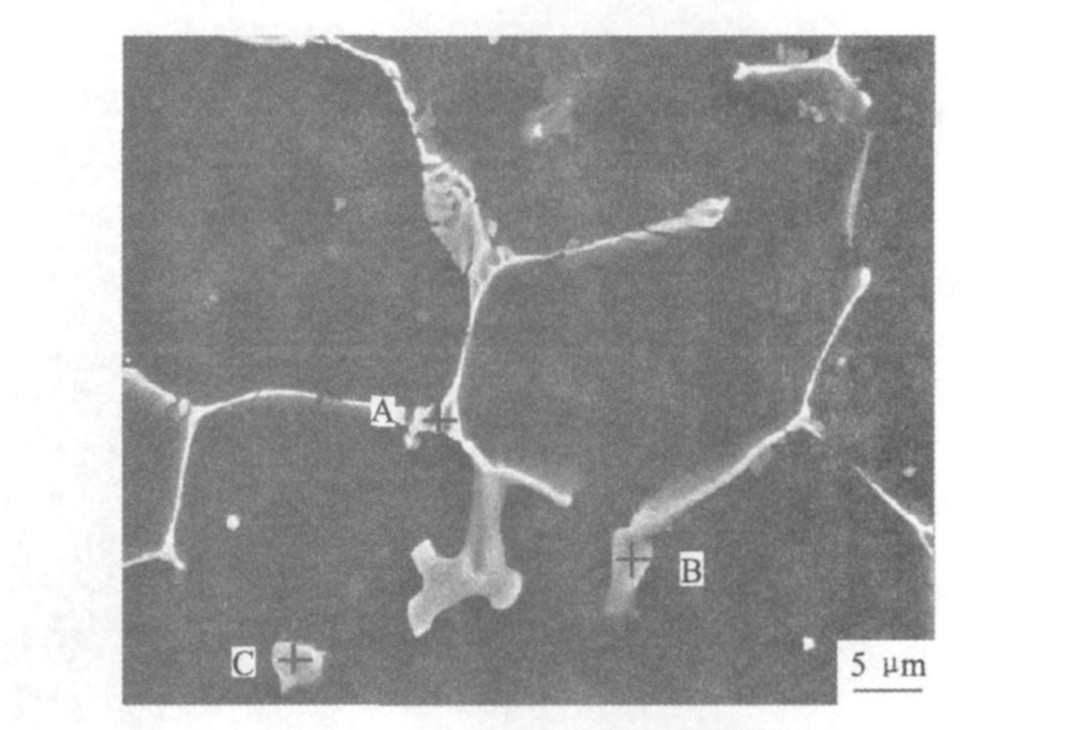稀土元素Sm对Mg-Zn-Y合金组织结构和力学性能的影响
北京有色金属研究总院稀土材料国家工程研究中心有研稀土新材料股份有限公司
摘 要:
制备了Mg-6Zn-1.5Y-0.8Zr-xSm(x=0,1,2,3)系列合金,研究了稀土元素Sm对Mg-6Zn-1.5Y-0.8Zr合金组织结构和力学性能的影响。通过金相显微镜、扫描电镜、EDS、XRD等观察和分析了合金的微观形貌和组织结构,测量了合金抗拉强度、屈服强度和伸长率等力学性能。结果表明:合金中添加稀土元素Sm后晶粒有了明显的细化,随着Sm元素含量的增加,晶粒细化效果更为明显;通过XRD分析,添加Sm元素后,合金中并没有出现新的含Sm的物相,通过扫描电镜和EDS分析表明,合金中加入的Sm置换了部分Y,形成了Mg3(SmY)2Zn3,Mg3(SmY)Zn6的相结构,Sm元素对Y的置换主要出现在Mg3(SmY)Zn6结构当中,在Mg3(SmY)Zn6相结构出现较少;力学性能测试结果表明,随着Sm含量增多,合金晶粒细化,细晶强化作用明显,合金屈服强度逐渐增大,而抗拉强度和伸长率在Sm含量为2%时达到最大,比未添加Sm元素时提高约15%以上。
关键词:
中图分类号: TG146.22
作者简介:赵永成(1987-),男,宁夏人,硕士研究生;研究方向:高性能镁合金;颜世宏(E-mail:yanh26@sina.com);
收稿日期:2011-02-25
Influence of Sm on Microstructure and Mechanical Properties of Mg-Zn-Y Alloys
Abstract:
The Mg-6Zn-1.5Y-0.8Zr-xSm(x=0,1,2,3) series alloys were prepared and the influence of Sm on microstructure and properties of Mg-6Zn-1.5Y-0.8Zr alloys was investigated.The morphology and microstructure of the alloy were researched through microscope,SEM,EDS and XRD methods.The mechanical properties such as ultimate tensile strength(UTS),yield strength(YS) and elongation(EL) were measured.The results showed that Sm could refine as-cast microstructure of Mg-Zn-Y alloy and refinement effect was more apparent when the content of Sm was increased.The phase contained Sm was not found during XRD analysis and it was found that some Y was replaced by Sm and recreated new phase structure like Mg3(SmY)2Zn3 and Mg3(SmY)Zn6 in the alloy.Sm replaced Y mainly in Mg3(SmY)2Zn3 phase structure and rarely existed in Mg3(SmY)Zn6 phase structure.The results of mechanic property test showed that the refined grains caused refinement effect,and the YS of the alloy increased slowly as the content of Sm increasing.The UTS and EL both reached maximum when the content of Sm was 2%,which increased about 15% compare to the alloy has none samarium.
Keyword:
magnesium alloy; rare earth metal Sm; microstructure; mechanical properties;
Received: 2011-02-25
镁合金由于其密度低、 强度高、 耐热性好等特点已经成为汽车材料未来发展的主要方向之一
Mg-Zn-Y系合金是重要的应用镁合金系列之一, 具有良好的使用强度和高温力学性能, 广泛应用于飞机和汽车的发动机、 齿轮箱壳体上
1 实 验
制备合金所用原材料为: 纯镁锭、 镁锆中间合金、 镁钇中间合金、 锌棒、 镁钐中间合金, 其中中间合金成分见表1。
熔炼合金具体成分配比见表2。
合金采用中频炉在氩气保护下熔炼。 将配好的原材料放入不锈钢坩埚中, 升温至780~800 ℃, 观测到合金完全熔化, 合金液表面发亮时保温3 min, 浇铸至底注式铸模中, 自然冷却。 铸模材质为铸铁。
浇铸得到的合金用线切割切出小块试样, 用车床加工成Φ5 mm的标准拉伸试样, 用MTS810电液伺服材料试验机测试拉伸性能(拉伸试样设计依据:GB/T228-2002金属材料室温拉伸实验方法); 从合金的中部切割取样, 经打磨、 抛光后, 在MeF3金相显微镜下进行微观组织结构的观察, 实验使用的浸蚀剂为4%的硝酸酒精溶液; 使用JSM-6510扫描电镜及能谱仪观察合金显微组织并进行合金成分辅助分析; 合金中物相在D/Max-2400型X射线衍射仪进行衍射相分析, 实验条件为: Cu靶Kα线, 电压为40 kV, 测量角度误差小于0.020(°), 试样截取自浇注试样中部表面磨平。
表1 镁中间合金成分比例表(%, 质量分数)
Table 1Proportion of ingredients in magnesium intermediate alloy(%, mass fraction)
| Intermediate alloy | MgZr(Zr) | MgSm(Sm) | MgY(Y) |
| Alloying element content/% | 30.10 | 29.77 | 71.47 |
表2 试验合金化学成分(%, 质量分数)
Table 2Chemical composition of test alloys(%, mass fraction)
| Test alloys | Mg | Zn | Zr | Y | Sm |
| MS00 | Bal. | 6 | 0.8 | 1.5 | 0 |
| MS01 | Bal. | 6 | 0.8 | 1.5 | 1 |
| MS02 | Bal. | 6 | 0.8 | 1.5 | 2 |
| MS03 | Bal. | 6 | 0.8 | 1.5 | 3 |
2 结果与讨论
2.1 物相组织分析
对各个合金样品进行XRD分析, X射线衍射图谱对比如图1。
由XRD分析可以看出, 未添加稀土元素Sm时, 合金中主要物相为: α-Mg, Mg0.97Zn0.03, Mg3Y2Zn3, Mg3YZn6和Mg12YZn, 添加稀土Sm元素后, 合金中的主要物相结构并未发生改变, Sm元素并未与合金中的其他元素形成单独的物相, 主要的物相结构仍为α-Mg, Mg3Y2Zn3, Mg3YZn6。
2.2 试样显微组织结构分析
对4个合金试样分别进行金相观察, 其组织结构对比如图2。 根据凝固原理和Mg-Y, Mg-Sm
图1 MS系列合金XRD分析对比图
Fig.1 X-ray diffraction analysis and comparison of MS series alloys
图2 MS系列合金显微铸态组织
Fig.2 Microstructure of MS series as cast alloys
(a) MS00; (b) MS01; (c) MS02; (d) MS03
通过扫描电镜观察不同试样中的微观结构, 对不同的析出相进行EDS扫描。 在MS00号合金当中, 主要析出相如图3中的A, B, C 3种情况, 各点的元素成分EDS分析结果如表3。
根据文献
图3 MS00号合金扫描电镜照片
Fig.3 SEM photo of MS00 alloy
表3 图3中不同点处物相的元素组成(%, 原子分数)
Table 3Elemental composition of different phases in Fig.3(%, atom fraction)
| Element | A | B | C |
| Mg | 82.68 | 65.79 | 47.73 |
| Y | 06.63 | 9.86 | 06.76 |
| Zn | 10.69 | 23.35 | 45.51 |
| Zn/Y | 1.6 | 2.4 | 6.7 |
在MS00合金成分基础上添加不同比例的Sm元素后, 直接观察合金的微观结构并未发生大的改变, XRD分析结果也显示合金中并未出现新的物相结构。 但从EDS分析中可以发现: Sm元素的添加使得合金中的物相成分有了一定的改变。 Sm和Mg的原子半径相差不大(Mg 1.60×10-10 m, Sm 1.79×10-10 m)
从图4和表4中的元素分布可以看出, 在MS00基础上添加Sm之后, 在鱼骨状的共晶组织中(图中A1~A4点处), Sm元素的含量较少, 只有少量的Y元素替代为Sm元素; 而在基体中析出的块状Z相组织中(图4中B1~B4点处), Sm元素对Y的替代量较多, 并且随着Sm元素加入量的增多, Z相中的Sm含量逐渐增多。
2.3 力学性能测试
对合金样品进行标准拉伸试验, 其力学性能对比见图5。 纵坐标所表示的分别是不同编号合金的抗拉强度(Strength)和延伸率(Elongation)的变化情况。
图4 MS系列合金的扫描电镜照片
Fig.4 SEM photos of MS series alloys
(a) MS00; (b) MS01; (c) MS02; (d) MS03
表4 图4中不同点处物相的元素组成(%, 原子分数)
Table 4 Elemental composition of different phases in Fig.4(%, atom fraction)
| Element | A1 | B1 | A2 | B2 | A3 | B3 | A4 | B4 |
| Mg | 82.22 | 46.04 | 83.18 | 22.21 | 79.14 | 17.83 | 66.82 | 20.76 |
| Y | 03.69 | 03.76 | 02.59 | 03.26 | 03.95 | 03.31 | 05.64 | 03.34 |
| Sm | 02.64 | 04.69 | 03.55 | 08.77 | 04.24 | 09.14 | 07.19 | 09.44 |
| Zn | 11.45 | 44.51 | 10.69 | 65.27 | 12.67 | 69.72 | 20.34 | 66.46 |
| Zn/(SmY) | 1.80 | 5.40 | 1.70 | 5.80 | 1.60 | 5.60 | 1.60 | 5.20 |
图5 MS系列合金拉伸试验结果对比图
Fig.5 Result of tension test for MS series alloys
通过图5可以看出, MS02号合金的力学性能较好, 最大抗拉强度和伸长率相对其他样品都是最高的, 这是因为随着Sm元素的加入, 一方面Sm元素起到细晶强化作用, 另一方面Sm替代出得Y元素越多, 析出的强化相Mg3(SmY)Zn6越多, 起到了析出强化作用, 从而使得合金力学性能得到提高; 而随着Sm元素的继续添加, MS03号合金晶粒粗化严重, 导致力学性能变差, 从图5中也可以看出MS03号合金的最大抗拉强度和伸长率值都出现了下降。 屈服强度随着Sm元素含量的增加呈现出缓慢递增的趋势。
从图3金相照片可以观察得到随着Sm元素的添加合金晶粒出现明显的细化, 产生细晶强化效果, 因此MS01和MS02号合金的力学性能有所提升。 Sm元素含量进一步增加后, 在MS03号合金晶界上析出大量共晶组织, 通过EDS分析可以确定晶界上的共晶组织主要为Mg3(YSm)2Zn3, Mg3(YSm)Zn6。 而当Sm元素添加量为3%时, 从图3可以看出晶界明显粗化, 大量析出的晶界共晶组织容易造成受力过程晶界滑移, 削弱了合金的力学性能。 通过试验分析得出Sm添加量在2%时所制备合金力学性能最佳。
3 结 论
1. 在Mg-6Zn-1.5Y-0.8Zr合金中添加Sm元素后, 合金晶粒有明显的细化现象, 并且Sm元素添加越多, 晶粒细化效果越明显。
2. Mg-6Zn-1.5Y-0.8Zr合金中主要物相成分由α-Mg, Mg3Y2Zn3, Mg3YZn6组成, 添加Sm元素后, Sm替代部分Y, 形成Mg3(SmY)2Zn3, Mg3(SmY)Zn6的相结构, 并且Sm元素对Y的置换主要出现在Z相(Mg3(SmY)Zn6)结构当中, 在鱼骨状的共晶相W相(Mg3(SmY)2Zn3)结构中Sm元素含量较少。
3. Sm的添加量对合金力学性能有一定的影响, 在Sm添加量为2%时合金的最大抗拉强度和伸长率都达到最高。
参考文献







